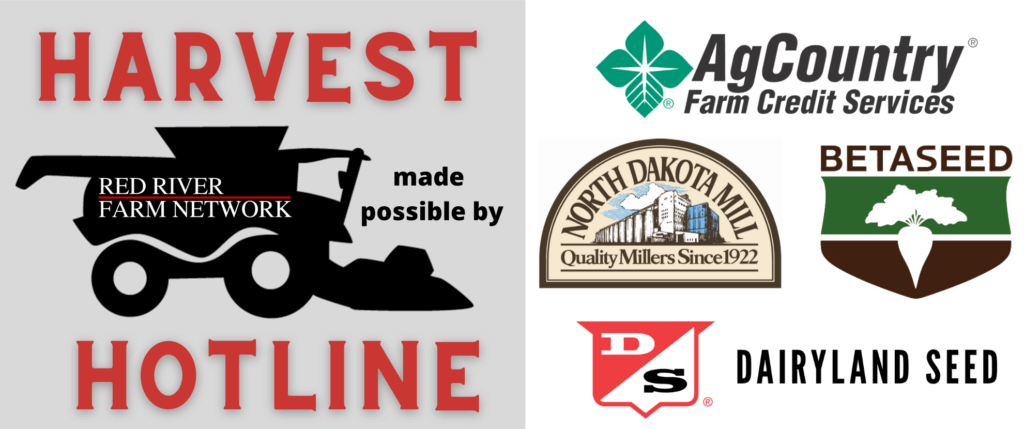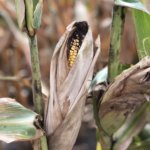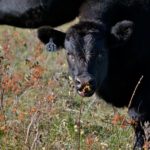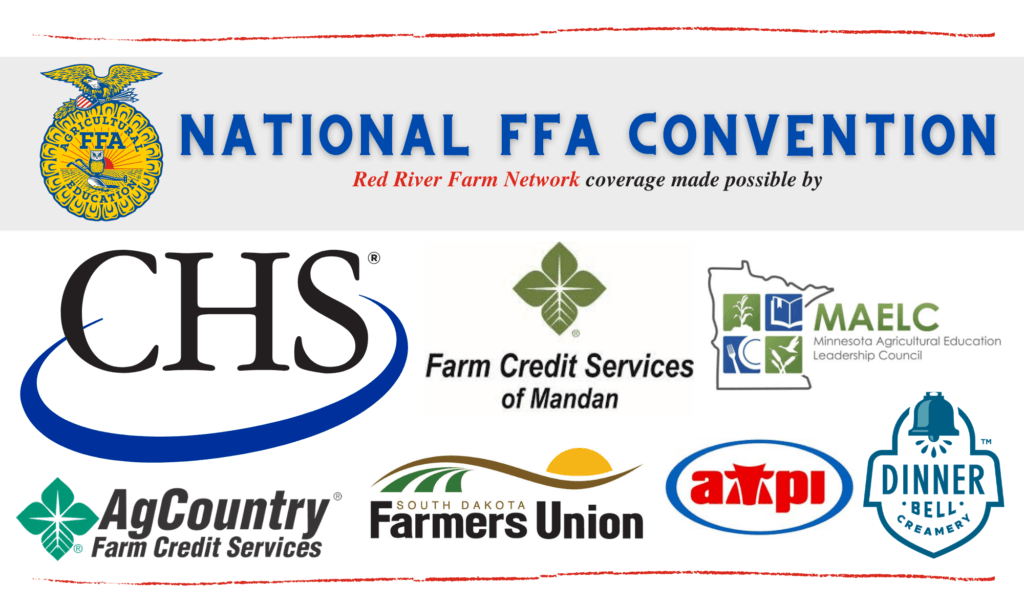
A Weekly Update from the Red River Farm Network
Monday, October 26, 2020
Reporting Agriculture’s Business – In this week’s edition of FarmNetNews, you’ll find updates from the Crop Insurance Professionals Association fall meeting in West Virginia. The Red River Farm Network also has coverage ahead of this week’s National FFA Convention. The FFA is having a virtual convention with numerous live and on-demand broadcasts. RRFN is also featuring FFA officers and award winners from the region in our coverage. Finally, Election Day is just one week away. Elections have consequences. Voting is an opportunity to stand up for a variety of issues, including farm policy, taxes, healthcare and education. Please, vote.
WHIP+ Program Addressed at Crop Insurance Meeting – Pro Farmer Washington policy analyst Jim Wiesemeyer told crop insurance agents the WHIP+ program is a well-intended program, but its implementation is a disaster. “It’s one of the worst implementations I’ve seen from the USDA in recent years. There’s some reasons for that,” said Wiesemeyer. “They’ve had a drainage of staff and they haven’t replaced that and the program is very complex, like a Rubik’s cube.” There’s also the unannounced quality loss adjustment part of the WHIP+ program. “I’ve been told by the end of this month the details will be out, but what we see may leave a lot to be desired. I think the USDA took a very passive approach and it won’t have much funding. It will be prorated and I don’t think there will be a lot of joy if they make that announcement.”

Second WHIP+ Payment Determined by the Availability of Funds – Farmers always want to see their income coming from the market rather than in the form of government support. USDA Undersecretary Bill Northey says there is some short-term optimism. “There is a breath of relief that we can actually see markets go up; it felt like they went down for seven straight years.” Northey says programs like CFAP have been a bridge to help farmers during the pandemic. WHIP+ has been another form of assistance for farmers. The second payment won’t be decided until USDA knows if it has enough money to meet the demand. That will be influenced by the signup deadline at the end of the month. Speaking at the Crop Insurance Professionals Association meeting, Northey said over a billion dollars in WHIP+ payments have been made, but it has been a lengthy process. “It is a complicated signup process and we have folks still getting information to FSA offices and we have buried FSA offices with CFAP and all of the other programs we’ve got. There’s $5.5 billion in ARC and PLC payments out. We have CRP payments out. We still likely have quite a few more payments on the WHIP side to go yet.” RRFN’s interview with Northey can be found online.
Questions Remain on Status of 2019 WHIP+ Payments – There are fewer than 10 days left until the WHIP+ program sign-up closes and some farmers still waiting on half or all of their payments. Texas A&M University Agriculture and Food Policy Center co-director Bart Fischer says there isn’t a clear answer when farmers will get their payments or if they’ll get the remaining 50 percent for the 2019 crop losses. “The USDA needs enough money to go around. I’m getting mixed messages on whether there will be enough to pay out the second 50 percent on 2019, but I suspect that will bleed into conversations Congress will have in the lame duck session, which may also involve extending WHIP and providing additional funding.” The USDA is also still holding the details of the quality loss adjustment program close to their vest. It will be its own separate program and Fischer expects it to roll out quickly. “They want to get it right.”
Hoeven: Quality Loss Formula is Coming – North Dakota Senator John Hoeven emphasizes crop insurance is the Number One risk management tool for farmers. In addition, Congress responded to trade related losses, weather challenges and the pandemic with relief packages. At the Crop Insurance Professionals Association fall meeting, Hoeven said USDA is working overtime to provide that help to farmers. The quality loss formula for the WHIP program is still being determined. “The reason it has taken so long because we have these other things that have moved ahead of it whether it is MFP 2, CFAP 1 and CFAP 2. It is coming, but it just got behind these other programs, which are larger programs.”

Higher Prevent Plant Acreage in 2019 Brings Changes for 2021 – The USDA says there are 10.2 million prevent plant acres across the country this year as of October 1, with North Dakota contributing about one-third of those acres. The prevent plant situation is much better than last year, but USDA Risk Management Agency Administrator Martin Barbre says it’s still an above average year across the country. “Normally, we average five to six million acres of prevent plant each year.” Following the 2019 prevent plant situation, a prevent plant task force got together to present changes to make the program more flexible for producers. Now, there are prevent plant and quality loss updates coming for crop insurance in 2021. Barbre gave an overview of the prevent plant changes and others during the Crop Insurance Professionals Association meeting this week. Watch the interview for a few more details.
CIPA Members Explore Ways to Improve Crop Insurance – Crop Insurance Professionals Association board chairman William Cole says there’s always work being done to improve the crop insurance program. “Our crop insurance program is tied up with the Farm Service Agency programs. We’re constantly working at ways of which we can help out with the farm program sign-ups that are coming along.” Cole has been involved in crops insurance for 25 years and says a lot has changed in that time. “The program has evolved to where we had very little participation in the mid-90s and the rates were too high. Working with the Risk Management Agency, we’ve changed the program and have great participation. Every year we’re constantly getting more products out and covering the risk farmers experience.” Watch our interview with Cole.
Quality Loss Changes Ahead for Crop Insurance – Heritage Insurance Services owner and CEO Tyler Bjerke says quality losses are part of changes in crop insurance next year. “Last year, the wheat growers spearheaded a quality endorsement issue where they were able to buy back their quality they lost in falling numbers. Since then, we’ve been able to expand that to other crops. Almost all crops in North Dakota will be able to buy back their quality, with the exception of dry beans and sugarbeets. Quality will be big for 2021 and there will be some prevent plant changes.” Prevent plant is still part of the story for Northern Plains farmers this year, but overall, harvest is making progress. Watch the full interview with Bjerke.
2020 Field Conditions Top-of-Mind at Crop Insurance Meeting – Elbow Lake, Minnesota-based Farmers Agency Incorporated insurance agent Matt Allen says field conditions have been fantastic in the area, helping harvest progress. The snow coming through slowed things down. Harvest and the weather are big topics at the Crop Insurance Professionals Association fall meeting. “The yields are coming in a little higher than the APH. Conditions have been fantastic compared to last year. It won’t quite be the slog we saw last year.” Allen, the vice-chairman of the CIPA legislative committee, says a panel of USDA staffers reviewed some common questions on ad-hoc programs during the meeting. “It’s important for farmers to sign up for the WHIP+ program by October 30. There is going to be some time after that they are going to have to figure out the payments, but the important part is to make sure farmers get their application into FSA.”
Crop Insurance Improvements Seen for Alfalfa – The crop insurance program continues to evolve. Recent changes include a new Quality Loss Option, a new unit structure assignment option for Enterprise Units and new procedures for Multi-County Enterprise Units. Glenda Blindert is a crop insurance agent in Salem, South Dakota and has been involved in the development of a new product for alfalfa. “The forage seeding policy covers alfalfa from the first year you seed it to that first summer and first winter. If it winterkills or drowns out, you get paid for those acres. Now, we’re also able to add in fall seeding and by fall seeding I mean by August 31.”
Farm Bill Discussions Expected to Begin in 2021 – Arkansas Senator John Boozman, a senior Republican member of the Senate Agriculture Committee, joined North Dakota Senator John Hoeven to discuss key issues impacting farm policy and crop insurance at the CIPA Fall Meeting. Boozman said farm bill discussions will begin for the committee in 2021. “The next farm bill will be in 2023, which will be here before we know it. We face many challenges and hopefully, our trade situation will be better and we continue to look for new markets.” The crop insurance program is a big part of the farm bill discussions. “It’s really been worked and used tremendously, because of the circumstances we’ve been in.”

Corn Harvest On Hold Near Perham, MN – Farmers near Perham, Minnesota were making good harvest progress before the recent snow. “The corn harvest will stall a little bit and hopefully, we’ll get warmer temperatures to start that back up,” said Brad Guck, agronomist, Professional Agronomy Services. “There’s a fair bit of the corn left to harvest with elevators full not being able to accept some crops of corn and soybeans. There’s still a long ways to go.” The soybean crop came off quickly. “It’s far better than last year with good yields in many cases. The market turned around too and hopefully, that turns things around.”
Good Test Weight and Quality – Corn harvest is almost wrapped up near Onida, South Dakota. “We started three weeks earlier than usual. The corn harvest started in the third week of September,” said Tim Luken, location manager, Oahe Grain. “Soybean harvest is complete and sorghum harvest is nearing completion. The sunflower harvest has taken a back seat and the area is more than five percent complete.” The corn crop is very good. “Yields on the corn vary from 140 to 170 bushels per acre, unheard of around here. Moisture of the driest corn is at 10.5 percent. The test weight is good and quality is excellent compared to last year.”
Snow Delays Corn and Sunflower Harvest in Onida, SD – Wednesday night’s snow delayed corn and sunflower harvest in Onida, South Dakota. “It looks like there’s some cold nights and days ahead so it may be awhile before the snow will melt away. We may also run into some muddy conditions as well when it does,” said Kent Braathen, custom harvester, Braathen Harvesting. The corn already harvested in the Onida area was dry, but fair. The sunflowers harvested before the snow came was good, too. Yet there won’t be an early finish to harvest. “We didn’t finish harvest in 2019 until right before Christmas. We were hoping to get done the first week of November this year, but I don’t think we’ll be done now until right before Thanksgiving.”
Iowa Farmers Still Dealing With Derecho Impact – Fall harvest is moving quickly in the Northern Plains, but in the Midwest, Iowa farmers are still dealing with the impacts of Derecho. “The moisture levels are very low. Up until the last few days, we’ve had dry weather. We haven’t had mold or anything, but it’s difficult when there’s corn down,” said Jack Tank, owner, Ag Risk Insurance Agency. “The Derecho was the largest single event in Iowa history of property losses, not just crops. We’ll be dealing with this for many years. The crop world will have it done by the end of the year, but there is still property damage all over the state.” Tank attended the Crop Insurance Professionals Association Fall Meeting earlier this week. Watch the video interview with Tank.
What’s Hot, What’s Not in the Markets – Advance Trading Risk Management Advisor Tommy Grisafi highlights the current market situation in What’s Hot, What’s Not in the Markets. A strong futures market and a strong basis is providing opportunities at harvest time.

Drier Corn at Harvest Helps MN Farmers Save on Propane – Donnelly, Minnesota Co-op Manager Bob Burner says harvest is beginning to wrap up. “The soybean crop is out of the way and most of the corn is harvested. Soybean yields are average and the corn yields are above average with good test weight. The thing that was so different was so much of our corn came out of the field under 20 percent moisture.” This means less propane sold for the co-op, but a big benefit for the farmers. “Farmers saved a lot of money in corn drying this year.”
Good Conditions Help the Canadian Harvest Move Rapidly – Farmers in Canada made good harvest progress this year with most of the harvest wrapped up. IntelliFARM Inc. president Brian Voth says most of Manitoba is done. “There’s a field of corn or sunflowers here or there, but even those are getting few and far between. Farmers are happy with how things got harvested and the yields were average to below.” The Western Prairies also were also able to finish up before snowfall. “There’s been pretty much no snow until this last week. Most of that was contained to the central Alberta area, where they finished harvest one week before that. This was the best harvest they’ve had in 10 to 11 years.”
Logistical Challenges Moving Crop to the PNW – Due to strong domestic and export demand, grain shippers are facing railroad delays to the Pacific Northwest. National Grain and Feed Association President and CEO Randall Gordon says railroad companies idled crews and locomotive power during the height of the pandemic and it takes time to ramp up again. “We’re starting to see spot incidents anecdotally of service delays in the Upper Plains, particularly into the export market in the PNW and the flour mills in Portland, Los Angeles and other areas.” Gordon says there has been challenges in securing rail cars and shuttle trains. Issues with major carriers have also impacted shortline railroads. “We’re starting to get those troubling indicators that this is a situation we need to watch closely.”

Rail Moving at a Steady Pace – North Dakota Grain Dealers Association Executive Vice President Stu Letcher says there hasn’t been an issue with rail traffic yet as shuttle turns to the Pacific Northwest have held steady at slightly more than two-and-a-half turns per month. “If we can keep that pace up, we’ll be in good shape. As we move into winter, it takes more crews and power to keep the pace up. That’s a concern, but hopefully, the railroads can do that.” Rail car prices are holding firm.
Good Export Sales Noted For Mid-October – Allendale Chief Strategist Rich Nelson says we continue to see very good corn export sales. “It’s the second best for this specific week. As far as the soybeans, the export numbers were within trade expectations and the grain markets reacted better than expected.” Nelson says logistics of getting the corn and beans shipped could be an issue down the road. “At this point, we’re not too concerned, but we are also watching to see if Brazil will buy anything from us.”
Brazil’s Planting Delays Could Extend U.S. Export Season – StoneX Group commodities market analyst Mark Lucas says dry weather in Brazil is delaying planting progress, which will help U.S. exports. “The more it gets delayed, the longer the U.S. export season on corn and soybeans is, because typically by the end of January, South American exports take over to China. If they’re two to four weeks behind on planting, it extends our export season. That’s good for us and probably the biggest factor the rmarkets are watching.” Exports, in general, are chugging along. “Each day, there are more sales and you throw the weather scenario on top, it makes for better pricing.”
Second Crop Corn Planting Key for South America – A delay in soybean planting in Brazil is not usually a problem for the soybean crop. Corn Belt Marketing market analyst Larry Clay says the bigger issue is the timing of the second crop corn. “That takes us back to what-if those issues come up. When you look at the weather situation, there’s a La Nina pattern, not the most ideal conditions.” The uncertainty has traders looking at better demand for the U.S. “Add the mix of China buying and the unknown weather going forward, that starts delaying things.”
Beet Stock Snapshot – According to Acres & Shares broker Jayson Menke, last week there was one brokered American Crystal Sugar Company sugarbeet stock sale of 82 shares at $3,800 per share. Get more information on the Acres & Shares website.
Canola Futures Hits Record High Price – ICE November canola futures set a new record high of C$550.30 per metric ton during the trading day on Wednesday. Northern Crops Marketing and Investments president Brad Paulson thinks a combination of spread unwinding and rumors of a short sunflower crop in Russia may be the reason. “There’s an on-going discussion that Russia’s sunflower crop is poor. They were talking about putting export quotas on their sunflower oil and sunflowers.”
Dry Bean Scene – The dry edible bean harvest is virtually wrapped up across most of the U.S. Get an update in the latest Dry Bean Scene on the harvest from both Nebraska and Michigan. This program is made possible by the Northarvest Bean Growers Association, BASF, Johnstown Bean Company and SRS Commodities.

Oil State Lawmakers Push Back on Renewable Fuels – Senators representing oil states are urging EPA Administrator Andrew Wheeler to address the 2021 obligations under the Renewable Fuel Standard. The lawmakers contend efforts should be taken to safeguard the nation’s fuel supply. In addition, this group of 15 senators said volume requirements under the RFS should not exceed the ‘blend wall’ of ten percent ethanol blends.
Russell: Don’t Trust the Polls – Vice President Joe Biden is ahead of President Donald Trump in many of the national polls. The Russell Group President Randy Russell does not have a lot of faith in these polls. “To be very honest, some of these pollsters have done a terrible and pathetic job and the question is if they captured the sentiment of the country.” The congressional race between Collin Peterson and Michelle Fischbach in Minnesota’s seventh district is one of the high profile races happening nationwide. Russell spoke with Peterson this past week. “I’m a Republican, but I’ve always supported Collin Peterson because he has done a great job for production agriculture and the food industry.”
SD Corn Comments – Election Day is just one week away on Tuesday, November 3. Hear more in the latest Corn Comments from the South Dakota Corn Utilization Council.
The Political World is Watching Minnesota’s 7th District – This race is between House Agriculture Committee Chairman Collin Peterson and Republican challenger Michelle Fischbach. “It is probably the highest stakes race for ag on the House landscape and probably anywhere on the congressional landscape,” said David Wasserman, who is the House editor for the Cook Political Report. A new chair for the House Agriculture Committee would be a dramatic change. “If Democrats have to turn to a new leader for the ag committee, it is possible it could be a more SNAP-oriented chair such as Marsha Fudge of Ohio or David Scott from Georgia.” Speaking at the Crop Insurance Professionals Association fall meeting, Wasserman sees a good chance for the Senate to flip, giving the Democrats the majority. Regarding the presidential race, Wasserman said Biden will likely be sworn in on inauguration day.

Assistance Available for MN Hog, Turkey Producers and More – The coronavirus pandemic caused major hiccups in the food supply chain earlier in the year, particularly when it came processing and transportation of ag commodities. That’s why nearly $7.7 million of CARES Act funding is now available agricultural producers and meat processors impacted by the COVID-19. Over $4 million is available for hog farmers and $1.25 for turkey farmers who had to depopulate and dispose of those animals. Another $1 million is set aside for meat processing facilities. “Thankfully we’re seeing more stable supply chain,” says Thom Petersen, commissioner, Minnesota Department of Agriculture. “However, that doesn’t mean mean we’re out of the woods yet. There is still a small backlog of animals we’re working through. We’re prepared just in case there’s a relapse in that supply chain this winter.” This financial support also includes dollars for local food systems, Farm Business Management scholarships and Department of Agriculture grants. Hear more from Petersen in this Red River Farm Network interview.
MFU Minute – The Minnesota legislature recently pass a tax and bonding bill that included Section 179 conformity. Find out more from Minnesota Farmers Union President Gary Wertish in the latest MFU Minute.
Section 179 Conformity Signed into Law – Minnesota Governor Tim Walz has signed the bonding and tax bill. This includes conformity with the federal Section 179 expensing provision for farmers. That change is retroactive to 2018. The $1.9 billion bonding bill includes $627 million to improve roads and bridges.
MN Corn Matters – Section 179 conformity has a positive impact on Minnesota farmers. Find out more from Minnesota Corn Growers Association President Tim Waibel in the latest Corn Matters program.
A Milestone for Crookston’s Ag Innovation Campus – Agriculture and political leaders will participate in a groundbreaking ceremony Wednesday for the Ag Innovation Campus in Crookston. This campus will include a specialty crushing facility and a biodiesel plant. According to the Minnesota Soybean Research and Promotion Council, soybean production in northwest Minnesota increased by more than 300 percent in the past 20 years.
USDA Updates Organic Agriculture Report – Minnesota is ranked in the top ten for the number of certified organic farms with 635 farms. North Dakota has 117 organic farms and South Dakota has 68. Nearly $10 billion in organic products were sold last year in the United States. Livestock and poultry products represent the top sector for organic production at $2.5 billion. Milk was second on the list at $1.6 billion.

USDA Helps Minnesota Agriculture Stay Connected – Did you know more than 20 million Americans don’t have high-speed broadband connectivity? That’s why a grant from USDA is helping Minnesota farmers and ranchers stay connected. “They are innovators, creators and entrepreneurs,” said Agriculture Secretary Sonny Perdue during a virtual announcement. “Many farmers are doing direct marketing across the world. If they don’t have connectivity, they are cut off from many market places.” This investment is part of $550 million allocated by Congress in the second round of the ReConnect Program. Consolidated Telephone Company (CTC) will use $3 million of that funding for high-speed broadband services to over 800 people and two-dozen farms in central Minnesota’s Morrison County. “With farms having access to gigabyte connection, they’ll be able to utilize precision ag tools and quantify the progress of each crop,” said Kristi Westbrock, CEO and general manager, CTC. Minnesota Farm Bureau Federation President Kevin Paap echoes Westbrock’s comments, saying sustainability is a top priority for farmers and ranchers. “Precision agriculture helps increase that sustainability by using GPS, yield monitors and autosteer. Not only do we need it (broadband) at our kitchen tables, but we also need it out in the field.” Listen to the story.
China’s Hog Industry Trying to Recover from ASF Outbreak – China built nearly 13,000 new large-scale hog farms in the first three quarters of 2020 and restarted more than 13,000 hog farms that were shut down last year due to the African Swine Fever outbreak. A Chinese agricultural official says the country’s pork supplies heading into the Lunar New Year are expected to be 30 percent greater than last year, which could reduce pork prices compared to one year ago.
MN Beef Update – The Minnesota Beef Council does several types of outreach work throughout the year. Learn more from Director of Industry Relations Royalee Rhoads in the latest Beef Update.

Calf and Cow Nutrition Both Important During Weaning – The fall months have been dry throughout much of South Dakota, with the latest USDA pasture and rangeland conditions coming in at 31 percent poor-to-very poor. That has altered plans for cattle producers. South Dakota State University Extension cow/calf specialist Olivia Amundson says many have weaned calves early. “In a way it’s kind of the perfect storm. While pastures are dying out faster than expected, harvest is moving along and those corn stalks can be grazed sooner.” For the cattle producers who’ve already weaned, it’s important to be feeding those calves so they gain properly. Cow nutrition is important as well. “Now is the optimal time to put increase body conditions scores in cows. We want that cow to have a score no less than five at calving once she starts lactating.” Amundson offers more weaning, feeding and calving set up tips in this Red River Farm Network interview.
Milk Production Increases – Milk production in the 24 major milk producing states was at 17.2 billion pounds in September, an increase of 2.4 percent from one year ago. USDA also revised August production upward by nearly two percent from one year ago to 17.8 billion pounds. Minnesota milk production rose 2.7 percent from one year ago. South Dakota production increased a dramatic 12.3 percent.

Angus Convention is Coming Up in November – The American Angus Association is hosting a modified version of it’s annual meeting November 8-9 in Kansas City. This will not only be an opportunity to carry out business, but also further producer education. In a year where few things have been ‘normal’, the Angus Association is looking forward to carrying out ‘normal’ business. “This year has really been about change and modification,” says Mark McCully, CEO. “We’re excited for experts to join us and talk about fertility, AHIR inventory-based options and other great programs from the association.” Registration for both the in-person and online versions of the Angus Annual Meeting are available at angusconvention.com.
Income From Cull Cow Sales Not Included in CFAP 2.0 – USDA’s Coronavirus Food Assistance Program 2.0 differs from the first version of CFAP, excluding dairy farmers from receiving assistance for losses from meat produced from breeding animals. While milk production is the primary revenue stream for dairy farmers, significant income also comes from cull cows. A letter has been sent to Agriculture Secretary Sonny Perdue by 15 senators, including Minnesota Senators Amy Klobuchar and Tina Smith, asking USDA to reverse the decision preventing dairy cows and other breeding animals from eligibility for CFAP 2 payments.
EQIP Final Rule Released – USDA has released its final rule for the Environmental Quality Incentives Program. Nearly one year ago, the Agriculture Department received 600 comments on the interim final rule. That input was used in the final EQIP rule. Changes include the addition of incentive contracts and payments for incentive practices to support locally led conservation needs.

October is Co-op Month – National Co-op Month celebrates the impact cooperatives have on our daily lives. One out of every three Americans are members of a cooperative and there are more than 40,000 cooperatives nationwide. With the cooperative movement, farmers leverage their combined influence for the good of all. This October Co-op Month message is brought to you by the North Dakota Farmers Union and Associated Milk Producers, Incorporated.
Co-op 100 Report Released – CHS remains the largest cooperative in the United States. According to the National Cooperative Bank’s annual report on the top 100 co-ops, CHS had 2019 revenues of nearly $32 billion. Dairy Farmers of America was ranked second and Land O’Lakes was third. CoBank, AGP, AgriBank and Basin Electric Cooperative were also in the top 20.

Ketterling a Finalist for the 2020 FFA National Star Farmer Award – Former North Dakota FFA President Cole Ketterling is one of four FFA members being considered for the 2020 National FFA American Star Farmer award. The Wishek, North Dakota resident started his own farming operation in high school. He farms part time now, raising cow-calf pairs, along with corn, spring wheat, soybeans and sunflowers. Ketterling would like to grow and expand the farm, making things more efficient. “I’m always looking to develop more balanced and specialized fertility programs, depending on the soil types and conditions. It helps save costs and improve yields.” Ketterling graduated from North Dakota State University in the spring and also works as an ag loan officer at Farm Credit Services of Mandan. “When it comes down to it, the whole farming industry is resilient. We’ve been through tough times, but farmers are adapting and changing, which is promising.” Cole Schock of Salem, South Dakota is a finalist for the National FFA American Star in Agricultural Placement.

Lentz and Smith Vying for National Office – Billie Lentz of Rolla, North Dakota and Maddie Smith of Minnesota’s Fillmore Central FFA Chapter have advanced to the final round for the national FFA officer selection process. In a typical year, the National FFA officer team spends about 300 days on the road, meeting with FFA members, alumni and industry stakeholders. “Most of that is still going to be carried out this upcoming year, but what it looks like will be determined by what is happening in the news and our world,” said Smith. “The mission still remains, nonetheless, to really help make a positive difference in the lives of students.” The Red River Farm Network coverage of the National FFA Convention is sponsored by CHS, AgCountry Farm Credit Services, AMPI and its Dinner Bill Creamery, the South Dakota Farmers Union, Farm Credit Services of Mandan and the Minnesota Agricultural Education Leadership Council.
North American Leaders Sign Communique at Tri-National Ag Accord – Agricultural leaders from Canada, Mexico and the U.S. wrapped up three days of discussions surrounding trade, COVID-19 response and more. This was the first Tri-National Ag Accord since the U.S.-Mexico-Canada Agreement went into effect in July. Mexican Association of Secretaries of Agricultural Development President Carlos Muniz Rodriguez said the countries are facing historic challenges with COVID-19, contraction of consumption and loss of employment. “We’re working on being able to still deliver food to the tables of our families.” Ideas were also shared about how all three countries can support each other’s agriculture industries during the coronavirus pandemic. Manitoba Minister of Agriculture and Resource Development Blaine Pedersen said that can be done through research and innovation. “We want to make sure all of that technology is also available to farmers in the other countries, too.” At the conclusion of the virtual gathering, members of the National Association of State Departments of Agriculture (NASDA) and their counterparts from Mexico and Canada signed a joint communiqué highlighting the successful implementation of the trade agreement. “It highlights the strength of agriculture in our three countries, as well as helps identify ways to help make the trade agreement better,” said NASDA President Ryan Quarles. Listen to the full Red River Farm Network story.
California Court Won’t Hear Roundup Appeal – The California Supreme Court will not hear an appeal by Bayer regarding the use of Roundup herbicide. A jury had awarded a $20 million judgement to school groundskeeper who has cancer. Bayer, which acquired Monsanto, now has few legal options left other than paying the judgement.
FMC’s Vantacor Gets EPA Approval – FMC has received EPA approval for its Vantacor insect control for different crops, including corn, soybeans and potatoes. Vantacor insect control is a highly concentrated formulation of Rynaxypyr, the industry standard for long residual control of Lepidopteran pests. The insects controlled by this product include European Corn Borer, fall armyworm and soybean looper.
Leadership Change Coming for Smithfield Foods – Smithfield Foods President/CEO Kenneth Sullivan plans to retire in early 2021. Chief Operating Officer Dennis Organ will succeed Sullivan.
Fumasi Picked for RaboBank Leadership – Roland Fumasi has been picked to lead Rabobank’s Food and Agribusiness research team in North America. Fumasi grew up on a farm in California and joined Rabobank as an analyst in 2014.

Frankfort, SD Farm is Environmental Stewardship Award Finalist – Johnson Farms of Frankfort, South Dakota is the Region 7 award winner for Outstanding Environment Stewardship. The farm is operated by Alan and Mickie Johnson, along with their son Brian and his wife Jamie. The family focuses on improving soil health through holistic management decisions. Johnson Farms, along with six other regional finalists, will be considered for the 2021 National Environmental Stewardship Award at the national Cattle Industry Convention in February. Learn more about Johnson Farms in this video.
Canola Minute – The 14th Annual Canola Research Conference is coming up. Learn more from Northern Canola Growers Association Executive Director Barry Coleman in the latest Canola Minute.
NCGA Promotes Busse – Julie Busse is the new communications director for the National Corn Growers Association. Most recently, Bussee was NCGA’s senior communications manager. Previously, Busse worked for Osborn Barr, Pioneer and the RFD Illinois radio network.
Barnett Selected for NFU Beginning Farmers Institute – National Farmers Union chose 14 participants for its Beginning Farmers Institute. The ten-month program will focus on technical training, mentorship and leadership. Among the 14 selected is Britney Barnett of North Dakota.
Animal Agriculture Loses Long-time Advocate – A longtime reporter and lobbyist, who took on animal rights activists, has died. Steven Kopperud began his career as a journalist, including time at the Minneapolis Star-Tribune and Feedstuffs. Kopperud later founded the Animal Industry Foundation, now known as the Animal Agriculture Alliance.
Drache Passes – Hiram Drache, 96, authored nearly 20 books on agricultural history and entrepreneurship. Drache was also professor emeritus at Concordia College in Moorhead.
Last Week’s Trivia – Jimmy Carter is the president who was a peanut farmer from Georgia. Jacob Downing of Cargill wins our weekly trivia competition. Grant Lien of Versatile, Carver County feedlot officer Alan Langseth, farm business management instructor Robert Rick and John Shutske of UW-Madison earn runner-up honors. The ‘first 20’ rounds out with Jim Altringer of CHS Dakota Plains Ag, Ron Claussen of Ag Media Research, retired Westbrook farmer Dave Van Loh, Brian Rydlund of CHS Hedging, Brian Brandt of AgriFinancial, Keith Praska of Stone’s Mobile Radio, Renville County farmer Mickey Peterson, Peter Carson of Carson Farms, Keith Zikmund of Bremer Bank, Norm Groot of Monterey County Farm Bureau, Gary Sloan of BMO Harris Bank, media relations consultant Amy Herman, livestock management consultant Bruce Trautman, retired Minnesota Ag in the Classroom executive director Al Withers and Mark Haugland of Bayer.
This Week’s Trivia – There are four presidents on Mount Rushmore. They are George Washington, Thomas Jefferson, Theodore Roosevelt and one other individual. Who is the fourth president on Mount Rushmore? Send your answer to don@rrfn.com.
| RRFN Upcoming Events | |||
| October 27, 2020 - October 29, 2020 | 93rd National FFA Virtual Convention - Online | ||
| October 28, 2020 - October 29, 2020 | Virtual UAS Summit & Expo - Online | ||
| November 3, 2020 - November 6, 2020 | Northern Crops Institute Pelleting Course - Online Webinar | ||
| November 5, 2020 | Minnesota Ag & Food Summit - Online Webinar | ||
| November 5, 2020 - November 6, 2020 | SD Stockgrowers Association Annual Convention - Rapid City, SD | ||
| November 8, 2020 - November 9, 2020 | 137th Angus Annual Meeting - Kansas City, MO | ||
| November 12, 2020 | Sustainable Packaging Options for Ground Beef - Online Webinar | ||
| December 11, 2020 | MN Farm Bureau Annual Meeting - Online Webinar | ||
| November 20, 2020 | NDFB Annual Meeting - Bismarck, ND | ||
| November 21, 2020 | MN Farmers Union Annual Meeting - St. Cloud, MN | ||
| Contact RRFN | Don Wick (701) 795-1315 |
Randy Koenen (701) 795-1315 |
Whitney Pittman (701) 795-1315 |
Tyler Donaldson 701-795-1315 |
| RRFN Affiliate Stations | |||
| Aberdeen, SD – 105.5 FM | Ada, MN – 106.5 FM | Bagley, MN – 96.7 FM | Bemidji, MN – 1300 AM |
| Benson, MN – 1290 AM | Bismarck, ND – 1270 AM | Bismarck, ND – 1270 AM | Casselton, ND – 103.9 FM |
| Crookston, MN – 1260 AM | Devils Lake, ND – 103.5 FM | Fergus Falls, MN – 1250 AM | Fosston, MN – 1480 AM |
| Glenwood, MN – 107.1 FM | Grafton, ND – 1340 AM | Jamestown, ND – 600 AM | Langdon, ND – 1080 AM |
| Mahnomen, MN – 101.5 FM | Mayville, ND – 105.5 FM | Roseau, MN – 102.1 FM | Rugby, ND – 1450 AM |
| Thief River Falls, MN – 1460 AM | Wadena, MN – 920 AM | Worthington, MN – 730 AM | |
FarmNetNews is a production of the Red River Farm Network. RRFN is based in Grand Forks, North Dakota and provides news to farmers and ranchers across Minnesota, North Dakota and South Dakota.

- Follow RRFN on